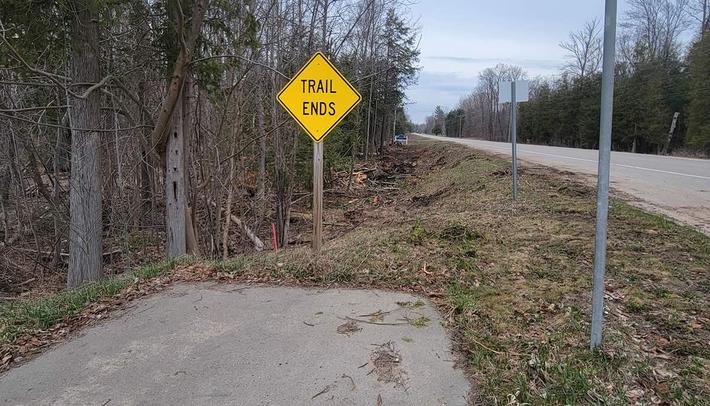
The Indian Farmer, 1850
"Progress" isn't always what it seems
By Mark Smith | Aug. 14, 2021
In the 1836 Treaty of Washington, D.C., the Odawa gave up vast amounts of land in exchange for certain benefits, one of which was receiving a government-appointed blacksmith and an Indian farmer for each settlement.
The great push to “civilize” the Indians (as they were then called) was essentially concentrated in efforts the American government believed would convert them from “roaming savages” to “settled” citizens. Chief among those efforts were encouraging Indians to become sedentary, abide in one place year-round, live in a house, attend church, attend school, and keep a garden and livestock.
The Indian farmer was key to this acculturation process. His job was to teach the Indians how to farm in the European way — with a plow, in rows, after felling trees with saws to make a clearing and pulling up stumps with oxen. Because keeping livestock was essential to this new style of farming, he would also teach them to build fences. Although each side had something to learn from the other, the Indian farmer wasn't there to learn; he was there to eradicate the Native Americans' old methods of growing crops in favor of the new way of the settlers.
The Odawa's old methods, of course, had helped sustain them. In addition to hunting, trapping, fishing, and making maple syrup in the spring, traditional Odawa communities kept large gardens that were generally operated as a communal enterprise, providing food for everyone. In the absence of oxen and plows, land was generally cleared by first girdling the base of large trees, removing their bark to weaken them so that the trees would die over time.
The following year the Odawa men would collect any downed wood and pile it at the base of the dry girdled trees, setting the wood on fire to complete the process of creating a clearing. Wood ash from these fires added to the fertility of the soil. The girdling and burning of trees made for a far less strenuous and, from a soil health perspective, more beneficial method of prepping the soil for plantings.
Wood ash from these fires added to the fertility of the soil. Girdling and burning the trees made for a relatively labor-free method of clearing for a garden. These gardens were generally abandoned after a few years, which meant that forward planning was needed to have a new clearing “on the go” for the eventual move to a new location. This was the Odawa style of native farming, and it was an important part of provisioning the tribe to survive the winter.
According to Robin Wall Kimmerer — botanist, Native American, and author of the bestselling memoir "Braiding Sweetgrass" — Native Americans typically raised corn, squash, and beans together in their garden clearings. They called the trio the "three sisters" for their familial interdependence. The corn would come up first, then the beans, which used the corn stalks for support. As the bean vines climbed, the squash or pumpkins would spread at the base of the corn stalk to help keep weeds down and the soil cool and moist.
These “three sisters” worked together in many ways, physically and microbiologically, and complemented each other in their growth. Weeds and insects existed then as now, but polycultures, fields with many species of plants, are known to be less susceptible to pest outbreaks than monocultures.
According to Kimmerer, this polyculture method of farming, though untidy to the European eye, actually produced more food per acre than traditional European-style farming, and with less labor. Kimmerer also makes a connection between the mixed varieties of vegetables grown together and the gifts of the individual in the tribe: “The gifts of each are more fully expressed when they are nurtured together than alone … Use your gift to take care of each other, work together, and all will be fed, they say.”
Thanks to the Indian Farmer’s oxen, Indians gradually adopted the new methods of tilling the soil, but a particular level of disgust was still reserved for the keeping of animals. An early Indian farming agent — i.e., Indian farmer — named Isaac Fairbanks reported that his charges “expressed openly their utter disdain for farming and their desire to continue hunting, trapping, and fishing. Rather than become "Slaves to their cattle and their hogs," Fairbanks recalled, they would rather, when they wanted meat, "take their rifles and get it; and when they returned to their wigwams, lie down and rest, instead of waiting upon and feeding their dumb brutes.’” (Old Wing Mission, Swierenga)
However, with land going fast to homesteaders, Indians saw their traditional way of life evaporating. No longer could they roam onto now-private land to hunt or fish. Essentially, they were catapulted from an ancient and traditional semi-nomadic lifestyle to a sedentary lifestyle in one generation. The magnitude of the upheaval cannot be overstated. In theory, the Indian farmer was there to help the Indians negotiate this massive cultural upheaval; in practice, the primary asset he provided was probably only the oxen.
The first Indian Farmer in Wakazooville — what is now the village of Northport, near the tip of Leelanau Peninsula — was James McLaughlin, a shipbuilder. By one account, McLaughlin was well-liked by the Indians.
According to Reverend Smith of Northport, “Mr. McLaughlin is in his 54th year — an illustrious, intelligent Christian man possessed of extensive mechanical skill … he will be useful among them [the Indians] as farmer, mechanic and Christian, and particularly in council, for they respect him much.”
While in Northport, McLaughlin built a boat for the Indians to share and use as needed, and he designed and helped build a bridge over Sucker Creek. It is not clear what agricultural assistance Mr. McLaughlin was able to provide, but documents suggest he was valued and well-liked. However, the post being a political appointment, with the arrival of Millard Fillmore in 1850, the Whigs pulled the plug on Mr. McLaughlin, and he was out of a job.
The new appointee for the post, Mr. John J. Merrill, soon showed himself to be less interested in working with the Indians and proved, in the end, to be confrontational and self-serving.
At the time of Merrill's appointment in October 1850, he had a 14-year-old son, Jackson. Jackson shared in his father’s contempt for the Indians he was supposed to be helping.
From the outset there were rumblings and discontent, with numerous small episodes of conflict between the Merrills and the Indians. On Jan. 3, 1853, after a particularly egregious episode of misbehavior at school, Smith sent a letter to Mr. Merrill, telling him that his son Jackson “cannot come to school on account of his bad conduct. He is very profane — dotes on his licentious conduct with Indian women (Shawun’s Sister particularly). So the Indians tell me. He has twice taken a club to strike Indians — first Pendunwan [Chief Peter Wakazoo] and, after, Payson [Wolfe], and his conduct has been very bad in meeting.”
Perhaps not surprisingly, following Smith's letter, young Jackson was expelled not only from school but also from church services.
Two days later, on Jan. 5, 1853, however, young Jackson Merrill appeared back at school. “Jackson came again & asked me if I was not going to teach him. I told him I thought not. He began to talk badly & continued for some time. I told him he had better not talk so. He replied, ‘I shall do something to you, Mr. Smith, besides talk.’ I told him he had better go outdoors if he did not talk differently. He must consider whose house he was in. He said, ‘I am in a government house and I shall say what I please.’”
Two days later, on Jan. 7, Reverend Smith was accosted by Indian farmer J.J. Merrill and his son Jackson in the street and subjected to verbal abuse and very nearly physical violence because of Jackson’s expulsion.
As Smith recounts in his diary: “This morning before I started to school, Mr. Merrill & son & Mr. Rice came this way & met me at the schoolhouse door. Mr. M. said he wanted to talk with me about his son. I told him well. He began & made himself so mad that he a good many times struck his fist at my face but did not hit me. He used very extravagant & bad language - and finally he said his son should go to school & I might help myself [apparently “whether you like it or not”]. His son talked worse than his father.”
Jackson Merrill then denied any wrongdoing, said everyone was lying about him and then “without any provocation and that I and my wife were the God damnedest liars there are in the world. I did not open the schoolhouse so he was obliged to go home.”
These events took place in front of others, including Payson Wolfe, his mother Kinequa, and John Baptist Wakazoo. Jackson called them all liars, to their faces, motivating Reverend Smith to write that the events of that morning “show him [Jackson Merrill] to be one of the lowest, most filthy & wicked young men I ever heard of.”
Just two months later, on March 7, Jackson Merrill struck again. He visited the Indians’ maple sugaring camp and demanded the use of copper kettles, by right, as the son of the Indian farmer, Smith writes: “Jackson Merrill went to Kinequa's Sugar Camp, said he wanted to borrow kettles. She told him she did not wish to let him have any. He persisted, she finally told him she would let him have 2 common-sized kettles. He said he would have 2 large ones. She refused. He then took 2 large kettles.”
A tussle ensued and Jackson knocked Kinequa to the ground. Kinequa called on another woman for help and “both of them succeeded in getting them [the kettles] away from him. He then drew his fist to strike them. They took each a stick and told him to strike. He said he would go and get 4 men and come and take all her kettles away.”
Jackson Merrill returned with Mr. Rice but by then Kinequa had hidden the large kettles and summoned reinforcements, John Baptist and Pepequa. Mr. Rice and Jackson settled for the smaller kettles, which Kinequa had offered them freely in the first place. Reverend Smith writes, “This is the way our farmer’s family is acting. They are going to make sugar on the village lot, though they have been twice forbidden. They are cutting the white ash for troughs, though they have been forbidden.” And they are appropriating kettles from Indian women.
Clearly, Indian Farmer Merrill didn't care as much for the Indians as he did in his own interests. It seems, in fact, likely that Merrill Sr. had sent Merrill Jr. to forcibly take the kettles for themselves.
The final word on this episode came the next day, March 8, according to Smith: “Kinequa was here this morning to breakfast, said that Jackson tried a long time to get the kettles away from them. Many times she fell in the contest, that Jackson drew his fist many times to strike [the women]. He said he would kill her again and again and that she would ‘die today’, that she was just like Smith. On the whole, it appears to be one of the most wicked transactions I ever heard of.”
The tragic part of all this is that as early as October of 1851 the Indians had already taken the full measure of Mr. Merrill and determined him to be not only useless but also antagonistic. A petition was sent to the Superintendent of Indian Affairs asking for his removal.
Unfortunately, that petition has not yet been found, but what survives is Merrill’s rebuttal to the petition, written Oct. 22, 1851. In the letter, Merrill shows himself to be self-pitying and coarse, blaming others for his failures.
Merrill also recruited Joseph Dame to write a letter defending him, even though Dame had just newly arrived from Wisconsin (having served earlier as Indian Farmer at the adjacent Michigan peninsula, Old Mission) and not aware of the extent of Merrill’s depravity. Because of Dame’s letter undercutting the efforts of Reverend Smith and the Indians, Merrill is kept on as Indian Farmer and allowed to finish out his term, ending in December 1853. He would then be replaced by Shawun (Oshawan), a Native American himself, as the new Indian Farmer.
All seemed well again, but at the end of a year Shawun was only paid half of what he was promised, so he quit. Such were the times, such were the days, when Indians tried to find ways to persist and even prosper in the new world of the white man.
Trending

Walking in an Artsy Wonderland
Michigan Legacy Art Park is hosting the “Raindrops” artwork created by Dewey Blocksma and Patricia Innis at th... Read More >>
Seven Takeaways from Local Real Estate Agents for the Spring/Summer Market
The last few years in local real estate have been akin to what one local agent described as the “wild west,” w... Read More >>
Blazing the Boyne City to Charlevoix Trail
We’re getting ever closer to an interconnected northern Michigan thanks to ongoing work on the Boyne City to Charlev... Read More >>


